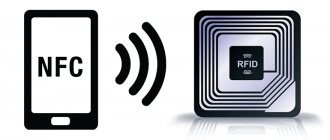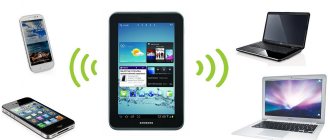Hello my dear friend! Today in the article we will discuss a rather interesting topic, which concerns the expansion of an existing wireless network. But in particular, I will tell you about a Wi-Fi access point, how it differs from a router, which is now in almost every home, and why it is needed in general.
Router and access point
To make it easier for you to understand what an access point is, first let’s look at the router. In another way, it is also called a router - this is a small box that receives a signal from the provider via an Internet cable. Roughly speaking, this is where the Internet connection goes.
Further from the name, you can understand that this transmitter builds a routing table in which all connected devices are recorded. As you probably already know, you can connect to the router’s network in two ways:
- By wire - a normal connection to one of the free LAN or local ports. Most often indicated in yellow. You can connect a TV, computer, laptop, network printer, CCTV cameras, etc. there.
- Wi-Fi is a technology that allows you to transmit and receive data using radio waves. The router has a built-in module or WiFi transmitter that sends and receives signals from other devices.
To put it simply, the router receives the Internet, builds a local network, connects devices to it and distributes Internet packets over this local network. Do not confuse the Internet and Wi-Fi - they are different things. Plus the router may have:
- Virus protection.
- Blocker of websites and dangerous content.
- Setting up a local media server.
- Firewall protection.
The functionality can be even wider. But most importantly, by default, all routers have a DHCP server enabled - this is a thing that automatically configures on any connected device: IP address, network mask, gateway and DNS servers. Without this, the device will not be able to connect to the router.
Everything here is like in the mail because in order to send a signal or a data packet, the router needs to know the address - where to send it. And without an address, the device simply will not understand where to send the Internet or other data.
An access point, or “Access Point” (AP) in English, is a device that receives a signal over a wire and distributes an existing local network in a given area using Wi-Fi wireless technology. Let me tell you with an example.
Vasily lives outside the city, he has a large, luxurious house. He also decided to build a small house nearby for his mother. He built and built and completed it. At home he has a powerful router, which is generally enough to cover the entire area and there is Wi-Fi in every corner.
But that’s not the problem - how to bring the Internet to your mother’s house? If you use conventional repeaters, the connection will be poor. Because he has a generator and power lines outside, and sometimes he tries to make it rain with a tambourine and his father’s old sweater. It’s clear that all this will extinguish the repeater signal.
But Vaska came up with an idea - to run a wire to his mother’s house. There is not much to pave there - only 20 meters. Here he laid the wire. Now another question is how to distribute from a router (to which a wire is connected to one LAN port) an already existing network with the Internet.
This is precisely what an access point is for. It simply receives a network with the Internet over a wire and distributes it to all devices in the local area. Now mom is happy and will be able to read books, watch movies and surf the Internet in peace.
To put it very roughly, an access point can be any device that is capable of receiving an existing network and distributing it via Wi-Fi. By the way, the router can also act as an “Access Point” and simply receive and distribute traffic from the main router.
What it is?
Using the global network has become very easy. The market is rich in a huge number of operators and providers that provide access to the network. Some time ago, only a select few had access to the Internet. For example, having purchased a very expensive computer and connected access via a modem at a speed of 56 K, from which it was necessary to dial a phone number that was always busy. Today everyone can afford the Internet. It has become not a luxury, but a banal necessity: for work, communication, information, games and more.
The average user has access from a personal computer, laptop, phone and other devices. However, to access the network, every user wants flexibility, so that there are no wires or additional equipment. It is in such cases that you have to deal with wireless assistants.
Most users do not distinguish between wireless devices and call them routers, routers, access points, and anything else. You can often hear customers complaining about their own Wi-Fi point, when in fact it turns out to be another device that does not even support the Fast Ethernet standard.
Important! A wireless access point or Wi-Fi access point is a special device for making a wireless connection to the operator’s network.
A router or router is a device that organizes access without or with a wire. It can route traffic between different network segments. A simple home router is simply a device that can organize a network environment for the user, independent of the operator. In this network, it is possible to register any home devices in varying quantities. This network is completely autonomous and independent of the service provider. Only the user can decide to connect new devices, limit or allow access to them.
The provider defines the endpoint simply as the service consumer's router.
An access point or Wi-Fi hotspot is something that does not have any signs of routing. Its operating principle is to switch packets and transfer them to the wireless part of the network from the wired one. It cannot function independently of the telecom provider. The decision to register new devices and limit their connection is made by the provider, and not by the user personally.
Connection operating modes
Let's take a look at the router first. It has a blue port for the ISP wire and local ports. Well, there are two antennas on the sides to strengthen the Wi-Fi signal.
But this instance is an access point and it has only one port. That is, the connection will be like this. Sometimes you can see the PoE port. It is designed for power supply via a network cable in places where there are no outlets.
NOTE! As mentioned earlier, another router can act as an access point. To do this, you just need to configure it by logging into the Web interface. But some devices have a special mode switch.
But the access point can also operate in “Bridge” mode. In this case, the second device connects to the first one’s network via Wi-Fi. And the wired port connects several devices. A regular switch will do for this.
But you can not use the wired port at all and receive and send the signal only over the air. In this case, the device turns into a wireless access point operating in “Repeater” mode.
There is another interesting mode of this device. It's called a WISP receiver. This technology is widely used in rural areas, where there are special WISP stations that distribute Wi-Fi with the Internet over several kilometers.
Where to choose
Who are Internet providers and what do they do?
Even after studying the issue and identifying all the differences between the devices under consideration, the average user will reasonably be interested in what to choose if the cost is identical, as is the appearance of the equipment. To answer the questions, you should consider certain parameters for creating networks on all types of equipment.
Router:
- Connects to the operator's network on its own behalf. You just need to set up a connection to the provider on the device and set the conditions for distributing data over your home network. Further, all equipment functions only in conjunction with the router, that is, to connect to the Internet, you do not need to configure all the equipment on the network.
- Affordable organization of an internal network between all types of office or home equipment. The router functionality itself will transmit the IP address to all devices.
- The router has a built-in firewall and firewall. These features provide additional protection to home equipment from remote, unconfirmed access from outside. This is a good addition to standard antivirus programs on a PC or laptop.
- Increasing the connection speed to the highest, thanks to which you can connect directly via LAN to the router. The Wi-Fi router has a function for setting connection speed parameters for each subscriber.
- Flexible setting of addresses is necessary for the normal functioning of some software. The router is capable of providing this opportunity.
TD:
- The device only provides a connection. If there are many laptops or PCs on the internal network, then they need to be configured separately. Such a system is not suitable for small service providers who independently configure the network and free subscribers from personal connection settings.
- Organizing an internal network between equipment can be problematic. An operator is required to resolve issues.
- The AP does not provide protection to the connection to the global network, but it does have encryption. The operator is responsible for protecting the connection independently.
- To get the best speed from your service provider, you need to connect to the network using a LAN, bypassing the AP. However, the overall connection speed is suitable for all tasks. There is almost no need to increase speed.
- The AP indicates the IP address as clearly as possible without providing the opportunity to make changes. This factor can be regarded as both negative and positive, depending on the tasks performed.
Varieties
First of all, they are divided into:
- External – installed outdoors. They have a stronger body, as well as protection from moisture, dust and cold. Before purchasing, be sure to check the permitted temperature range, which will depend on the winter in your region.
- Internal - installed at home and do not have special protection.
It can also be divided according to the form and method of connecting to the network:
- Receptacle - connection goes directly to the outlet.
- Tabletop - we have already talked about them. They have a separate connector for power, into which a separate unit is inserted.
Next, let's talk about how to choose an access point
access points and their application
Technical characteristics of the access point
Manufacturing materials
The device is divided into the following types based on materials of manufacture:
- For external placement. Used when you need to place the device outdoors or in other unpredictable environments.
- For indoor placement. Placement in an office or home.
It should be noted that the first type requires stronger materials in order for the device to work as long as possible.
Which is better 2.4 or 5 GHz?
The access point works mainly with two Wi-Fi and wired connections. But wireless technology is still the main one. Wi-Fi operates on the IEEE 802.11 standard, using two frequencies: 2.5 and 5 GHz. Not only the data transfer speed, but also the range will depend on the frequency and standard. The most basic standards are:
- a, b, g (2.4 GHz) – speed up to 40 Mbit per second.
- n (2.4 GHz and 5 GHz) – speed up to 600 Mbit per second.
- ac (5 GHz) - up to 6000 Mbit per second.
The best option would be to choose support for two frequencies: 5 and 2.4 GHz. As you can see, 5 GHz has a higher speed, plus it is more reliable in terms of data transmission over a short distance. There will be less response and packet loss is almost negligible. But as you probably know from physics, the higher the frequency of the wave, the faster it decays, so the radius will still be larger at 2.4 GHz.
Conclusion and additional recommendations
If it were possible to make an unambiguous choice between these devices, then most likely the router would defeat the access point and it would disappear from store shelves.
But, in fact, each device has its own purpose. If you need to organize a home network, the easiest way to do this is using a Wi-Fi router. A single network configuration setup and all your phones, tablets and computers have access to the Internet (over the air and via cable). To organize a HotSpot in a cafe or create a seamless network over a large space, you should pay attention to a wireless access point. You can buy a WiFi router in Kazakhstan or an access point in the catalog of our online store at the best price right now. We will arrange delivery for you to any city. Are you in Astana or Almaty? Take advantage of the pick-up service.
Tweet
Share 0
Telegram
Share
Antenna power
It is measured in decibels and increases the coverage radius of the WiFi zone. If the area is not large, then you can use internal antennas. But there will be a problem in expanding in the future. So, it’s probably worth purchasing with regular external 2-3dB antennas.
In cases where you can buy more powerful ones and change them. They are easy to unscrew and connect. But you can take it right away with a margin of 10-12 dB. The number of antennas also affects coverage, but on dual-band devices, you can enable two networks, 2.4 and 5 GHz. It all depends on the model.
Where are they used?
In most cases, a wi-fi access point, like many other access points, is used to provide Internet access to all kinds of mobile devices. For example, for tablets, mobile phones, laptops and some other devices.
In addition, a wireless access point can also be used in all kinds of establishments that want to provide Internet access to their visitors. In this case, they create a certain zone within the range of which it is possible to connect to the Internet. In some cases, such access may be absolutely free; in some cases, in order to gain access to the Internet, you need to order something (for cafes, restaurants and other similar establishments) or use some service. Such access points can also often be found in public places, such as airports, train stations, libraries, universities, etc.
It is also impossible not to note the popularity of wireless access points for creating home networks, which has only been increasing recently. This solution is very convenient, as it allows all devices to access the Internet. One access point is enough to provide Internet to one apartment. If necessary, the Internet can also be transferred to neighbors. Sometimes in such networks a laptop is used as a wifi access point, as this is very convenient and allows you to save on the purchase of special equipment.
Wireless access point device
By design, the access point resembles a client adapter. The difference lies in the greater number of intelligent functions and special electronics that the access point is equipped with.
As for the external design, all access points can be divided into two types. The first type is devices intended for use in outdoor conditions. They are usually protected from possible negative environmental influences. The second type is access points that are used inside office buildings, houses and other premises; such points are much less protected, since they have virtually no contact with the environment.
An important issue is the functionality of modern access points. The functions that these devices have can be completely different, it all depends on the device itself. In some cases, the device may have a number of very useful functions, which include: network monitoring, remote network configuration, diagnostics, remote troubleshooting and much more. Access points that have all these functions allow you to very finely and competently configure them to work, and also, in case of any problems, solve them as quickly as possible. In the same case, if the device does not have many of these functions, then setting up the access point may not be as quick and successful as neutralizing various types of problems.
It should also be noted that not so long ago routers went on mass sale that allow multi-user file sharing without using a server.
Application
Modern access points have a very wide range of applications; they can be used to connect groups of computers to the Internet in independent networks. They are also actively used as a bridge, allowing to combine different parts of the network, most often wireless with wired ones, and in many other cases.
When using these devices, do not forget the fact that when you connect to a router, the Internet speed is divided among all those connected. Thus, despite the fact that there are no restrictions on the number of connections, it makes sense to limit them, otherwise the Internet speed may drop to very low levels, which will be very inconvenient.
Real life example
Suppose you are faced with the following task. You need to create a wireless network, connecting a certain number of computers, and you must also connect the wireless network you created to a wired network. What is the best thing to do in this case? In this case, the best solution would be to use an access point.
Why is this method so good? The good thing about it is that you get a network device that does not depend in any way on the load of computers and their characteristics. Thus, you do not need to perform complex software settings and worry about the fact that any of the computers will not work or will not support this or that service.
What are the advantages?
As you know, to create a wired network, you need to lay a very large number of all kinds of cables, which can take a lot of time, effort and resources. In some cases, this is a completely justified decision, but in some cases the result does not justify the costs, and such cases occur very often.
That is why wireless networks are an increasingly relevant and used solution when it is necessary to connect a group of computers into a network. The advantages of such networks are quite obvious: they are less expensive, easier to manage, and computers can be placed in completely different places without fear of missing cables. Therefore, a Windows 7 wifi access point on a laptop or an iota access point used for such purposes can be a solution that will greatly facilitate this process.
How to choose a wireless access point?
If you plan to take advantage of all the benefits that a wireless access point can provide, in this case, you are probably interested in knowing what to look for when choosing one.
At the moment, the most popular access point is a Wi-Fi station, which, as mentioned above, has very great capabilities. Such a station allows you to both combine computers into one network and connect them to the Internet. What parameters are most important for such a device? Let's try to answer this question.
Standard Wi-Fi
Now there are various standards for such devices that are used in certain situations. One of the most relevant and one of the most universal is the 802.11n standard. A very big advantage of this standard is its compatibility with almost all modern mobile devices and laptops. This protocol allows you to have a connection speed of up to 600 Mbit/s. It is also impossible not to note the long operating distance of this standard and its increased sensitivity, especially when compared with many outdated protocols. This protocol is often used by the MTS access point, as well as the Megafon access point and many other cellular operators that provide Internet access services.
Recently, another interesting standard 802.11ac has appeared, which consumes significantly less energy and has high functionality. However, in our conditions, using this protocol does not yet make much sense. The fact is that most providers operating in the CIS do not offer their clients Internet speeds of 900 Mbit/s, and this protocol allows you to work at exactly these speeds. Thus, you will simply pay more and not take advantage of the speed benefits that this standard provides.
Antenna power and gain
It is the power, as well as the antenna gain, that are the parameters on which the quality of signal reception and transmission directly depends. Therefore, in order for a tele2 access point or a device from another operator to have a good range and a strong signal, you should pay special attention to these parameters.
If you plan to use the device at home, then a power in the range of 13 – 17 dBm should be enough. In the same case, if you need to use an access point in a large room, and you want to ensure a good coverage radius, you should definitely buy more powerful models. It should be noted that such a parameter as the power of the access point corresponds to the radiation level, that is, it affects the signal propagation range.
Such a parameter as the antenna gain characterizes the level of radiation of the device in one direction. Thus, the higher this coefficient, the higher the signal dissipation will be, and the lower its amplification will be. If you buy an access point for home use, then, for example, a gain of 9-10 dBi will allow you to achieve a good signal, but only in some places in the house. But a gain within 4-5 dBi will provide the whole house with a good signal.
Data encryption
Data transfer speed is a very important parameter for a device such as an access point . However, if the access point is not provided with reliable protection and high-quality data encryption, it can become an easy prey for experienced hackers. The fact is that by typing certain programs, as well as having certain skills and abilities, a hacker is capable of not only distributing the Internet from your point without authorization, but also completely gaining control over it. You probably don’t really want this, so be sure to pay attention to the type of data encryption that is used in the device you are interested in.
As most tests, expert opinion and practice show, the most reasonable choice at the moment is the WPA2 encryption standard. This standard will protect you from hacking and many other problems.
Therefore, if you are interested in a high-quality Beeline access point or something else, be sure to check whether it uses the WPA2 encryption standard.
Additional functions
There are a certain number of functions that any access point should have. However, in addition to this obvious list, additional functions are also sometimes found. In some situations, these additional features can be extremely useful.
Such functions can be completely different, as for the most common ones, at the moment the following can be noted:
- A function that allows you to connect a printer to a Wi-Fi station, which can be accessed from any computer on the network. This can be a very convenient solution for offices when there is a need to frequently print out certain documents, since this can be done from any computer.
- PoE support function, which allows you to transmit both information and electrical energy via twisted pair, which can be used to power various devices on the network.
- FTP server function, which allows you to store all kinds of files on the hard drive or flash drive of the access point.
If any of these functions may be useful to you, then be sure to buy a device that has it. Typically, such functions have a certain number of options, but do not worry about setting up a yota access point or any other access point that has these functions.
By price
Many companies are starting to add unnecessary functionality to “Access Point” type devices:
- DHCP.
- Firewall (Firewall).
- Ability to work in modem mode.
- Network settings and settings.
In general, turning it into an additional router. In this case, the price will be much higher than a regular router. I believe that the access point should be itself without unnecessary functions. When choosing, you should focus on support for Wi-Fi standards, antenna power and input port speed. And additional husk, as practice has shown, is not needed. And in cases where it is better to buy a regular budget router.
What affects the operation of Access Point
The Wi-Fi AP is unable to perform standard tasks of a router or router; the AP is not able to form a new network. The main task of the device is to connect to a ready-made infrastructure and enhance its main parameters. When used in a large room, the power of the equipment may not be enough, which requires assembling a set of several Access Points.
Functionality may be affected by:
- walls, partitions;
- household appliances operating in the same range;
- metal objects that reflect the signal.
Important! Sometimes the cause of an unstable connection is related to the performance of the underlying network equipment or problems on the service provider's side.
Impact on Wi-Fi signal
Internet “Everywhere” is present very quickly.
As we already mentioned, in many cases it is important to have a good Internet connection anywhere. The fact is that today we have the ability to easily connect wirelessly in public places such as shopping centers, train stations, airports...
However, sometimes this is not possible and we cannot connect our laptop, tablets or any other device that does not have its own network . For example, we can share the connection from our mobile phone. There are different options for this.
The main thing is that we live in a time when good Internet is necessary. This means working anywhere, getting information, keeping in touch with friends and family... Hence, the term Internet "everywhere" or anywhere is becoming increasingly popular.
Sometimes we need to look for different alternatives in order to be able to connect to the devices that interest us. This is where both Modem and Hot Spot come into play. These are similar terms that will allow us to connect to other devices, but they are not the same.











